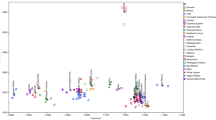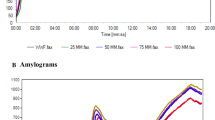Abstract
White brined cheeses and strained yogurt (Labneh) are the most popular dairy products in the Eastern Mediterranean. However, scant data are available on the nutrient profiles of these products. In the present work, 38 samples of regular and reduced-fat varieties of four white brined cheeses (Akkawi, Halloumi, Double Crème and Braided) and Labneh, produced from cow’s milk, were analyzed for basic nutrients (water, protein, fat, ash and lactose), cholesterol and selected minerals (Na, Ca, K, Mg, P and Zn). The moisture contents of Labneh (78.6 g·100 g−1) and Double Crème (60.3 g· 100 g−1) were higher than those of Akkawi, Halloumi and Braided cheeses (46.6–55.1 g·100 g−1). The fat content of full-fat Labneh was 8.8 g·100 g−1, while the full-fat brined cheeses contained fat levels between 18.3 and 23.9 g·100 g−1. Protein contents ranged between 8.9 and 24.8 g·100 g−1. Cholesterol strongly correlated with fat content and an increase in cholesterol/fat ratios was observed with decreasing fat levels. Sodium contents ranged between 151 and 5012 mg·100 g−1 while Ca levels ranged between 43 and 921 mg·100 g−1. The moisture contents indicated that Double Crème was a soft cheese while Akkawi, Halloumi and Braided cheeses were firm/semi-hard cheeses. The fat levels in dry matter (FDM) revealed that only full-fat Double Crème cheese with a FDM of 48 can be classified as full-fat while the other cheeses can be classified as medium fat, partially skimmed or skim. These data will be of use to dairy scientists and technologists, dietitians and bodies concerned with promoting healthier dietary practices.
Abstract
(Labneh) 38 (Akkawi, Halloumi, Double Creme Braided) (Labneh), (Na, Ca, K, Mg, P, Zn) Labneh (78.6 g·100 g−1) Double Crème (60.3 g·100 g−1) Akkawi, Halloumi Braided (46.6–55.1 g·100 g−1) Labneh 8.8 g·100 g-t1 18.3 23.9 g·100 g−1 8.9 24.8 g·100 g−1 Na 151∼5012 mg·100 g−1 Ca 43∼921 mg·100 g−1 Double Crème Akkawi Halloumi Braided Double Crème 48)
Résumé
Les fromages frais en saumure et le Labneh (lait caillé égoutté) sont les produits laitiers les plus populaires dans les pays situés à l’est du bassin méditerranéen. Cependant de rares données sont disponibles sur les profils nutritionnels de ces produits. Dans cette étude, 38 échantillons de 4 types de fromages frais en saumure (Akkawi, Halloumi, Double Crème et Braided) et de Labneh, à teneur normale ou réduite en matière grasse, produits à partir de lait de vache, ont été analysés pour leurs teneurs en nutriments basiques (eau, protéines, lipides, cendres, lactose), cholestérol et certains minéraux (Na, Ca, K, Mg, P, Zn). La teneur en matière grasse des Labneh «gras» était de 8,8 g·100 g −1 tandis que les fromages frais en saumure «gras» présentaient des teneurs en matière grasse de 18,3 à 23,9 g·100 g−1. Le cholestérol était fortement corrélé avec la teneur en matière grasse et une augmentation des ratios cholestérol/matière grasse était observée avec la réduction des niveaux de matière grasse. Les teneurs en sodium variaient entre 151 et 5012 mg·100 g−1 alors que les teneurs en calcium allaient de 43 à 921 mg·100 g−1. Les teneurs en humidité indiquaient que le Double Crème est un fromage à pâte molle, alors que l’Akkawi, l’Halloumi et le Braided sont des fromages fermes/à pâte demi-dure. Les niveaux de matière grasse sur extrait sec (G/S) montraient que seul le Double Crème à teneur non réduite en matière grasse peut être classé en fromage «gras» avec un G/S égal à 48, alors que les autres fromages peuvent être classés en « moyennement gras», « partiellement maigre», ou «maigre». Ces données seront utiles aux scientifiques et technologues du domaine laitier, aux diététiciens, et aux parties concernées par la promotion de pratiques alimentaires plus saines.
Similar content being viewed by others
References
Alichanidis E., Polychroniadou A., Characteristics of major traditional regional cheese varieties of East-Mediterranean countries: a review, Dairy Sci. Technol. 88 (2008) 495–510.
Andrikopoulos N.K., Kalogeropoulos N., Zerva A., Zerva U., Hassapidou M., Kapoulas V.M., Evaluation of cholesterol and other nutrient parameters of Greek cheese varieties, J. Food Compos. Anal. 16 (2003) 155–167.
AOAC, Official Methods of Analysis of AOAC International, vol. 2, 17th edn., Association of Official Analytical Chemists, Maryland, USA, 2000.
Celik S., Turkoglu H., Ripening of traditional Örgü cheese manufactured with raw or pasteurized milk: Composition and biochemical properties, Int. J. Dairy Technol. 60 (2007) 253–258.
Codex Alimentarius, Milk and Milk Products, 1st edn., FAO, Rome, Italy, 2007.
Dashti B., Al-Awadi F., Al-Kandari R., Ali A., Al-Otaibi J., Macro- and microelements contents of 32 Kuwaiti composite dishes, Food Chem. 85 (2004) 331–337.
Donmez M., Seckin A.K., Sagdic O., Simsek B., Chemical characteristics, fatty acid compositions, conjugated linoleic acid contents and cholesterol levels of some traditional Turkish cheeses, Int. J. Food Sci. Nutr. 56 (2005) 157–163.
Institute of Medicine, Dietary reference intakes for water, potassium, sodium, chloride, and sulfate, The National Academies Press, Washington, USA, 2005.
Mallatou H., Pappa E.C., Comparison of the characteristics of teleme cheese made from ewe’s, goat’s and cow’s milk or a mixture of ewe’s and goat’s milk, Int. J. Dairy Technol. 58 (2005) 158–163.
Mendil D., Mineral and trace metal levels in some cheese collected from Turkey, Food Chem. 96 (2006) 532–537.
Merdivan M., Yilmaza E., Hamamcia C., Aygunc R.S., Basic nutrients and element contents of white cheese of diyarbakír in Turkey, Food Chem. 87 (2004) 163–171.
Molkentin J., Cholesterol content and lipid composition of low fat dairy products, Eur. Food Res. Technol. 223 (2006) 253–260.
Nsabimana C., Jiang B., Kossah R., Manufacturing, properties and shelf life of Labneh: A review, Int. J. Dairy Technol. 58 (2005) 129–137.
Smith L., Schonfelst H., De Beer W., Smith M., The influence of factory and region on the composition of South African Cheddar and Gouda cheese, J. Food Compos. Anal. 14 (2001) 177–198.
Stähler F., Gruber W., Stinshoff K., Röschlau P., Eine praxisgerechte enzymatische Cholesterin-Bestimmung [A practical enzymatic cholesterol determination], Med. Lab. 30 (1977) 29–37.
Toufeili I., Ozer B., Brined cheeses from the Middle East and Turkey, in: Tamime A.Y. (Ed.), Brined cheeses, Blackwell Publishing Ltd., Oxford, UK, 2006, pp. 188–210.
Author information
Authors and Affiliations
Corresponding author
About this article
Cite this article
Jaoude, D.A., Olabi, A., Najm, N.E.O. et al. Chemical composition, mineral content and cholesterol levels of some regular and reduced-fat white brined cheeses and strained yogurt (Labneh). Dairy Sci. Technol. 90, 699–706 (2010). https://doi.org/10.1051/dst/2010026
Received:
Revised:
Accepted:
Issue Date:
DOI: https://doi.org/10.1051/dst/2010026




